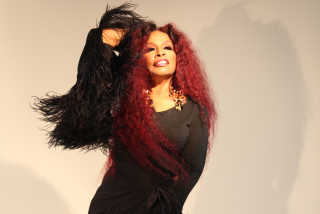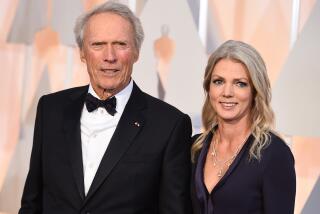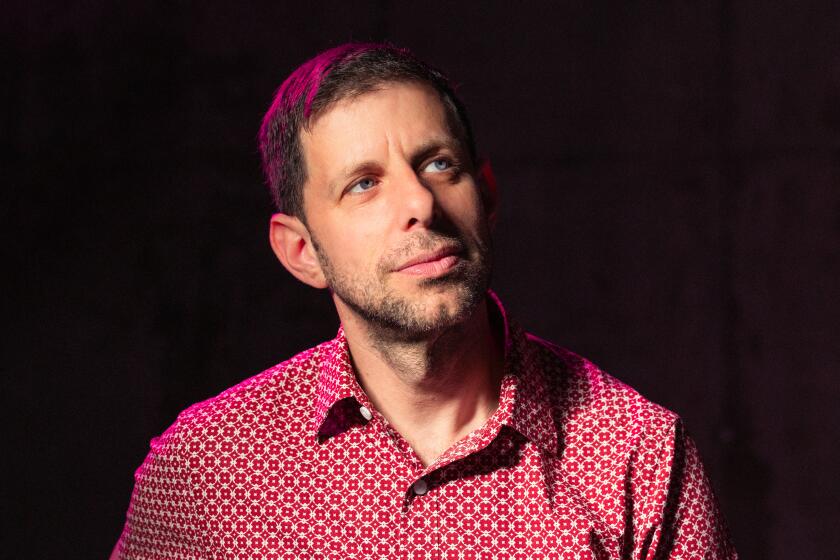Works’ energy is just so L.A.
“Into the Silver See-Through,” Chris Natrop’s first exhibition at Bank Gallery, is as enchanting an experience as its title would suggest. A wonderland of white paper cut into intricate foliage-like designs gives the effect of fantastical landscapes suspended around the gallery.
The show’s title piece is a dazzling 30-foot wave that begins in the top corner of one wall, where it appears to tuck under the head of an embedded column, and cascades in a long, undulating stream across the length of the gallery. The piece hovers about an inch from the surface of the wall, mounted on long nails, and a soft orange glow emanates from beneath it in places -- the wall’s reflection of the paper’s neon orange underside. Slender strips of Mylar trace through the wave like train tracks, emphasizing the swift, roller coaster momentum.
A second installation, “Landing Nowhere Else,” features lacy curtains of cut paper hanging maze-like from a net suspended overhead. The paper is stained here and there with faint traces of color (watercolor paint and green tea, according to the checklist). Spotlights positioned in different parts of the otherwise darkened room create dramatic shadow patterns across the walls and the other veils of tangled paper. The result is a delirious chaos, like a magical blizzard of paper snowflakes.
The forms that appear in these sheaths of paper are ambiguous. In some places, they suggest flowers, vines or tree branches; in others, power lines, explosions or stretches of skyline. The organic and the synthetic are so intertwined as to be virtually indistinguishable, creating a rich perceptual confusion. It all looks familiar, but the familiarity is impossible to pinpoint.
The show’s press release describes the work as a “meditation on the Los Angeles landscape.” (Natrop moved here recently from Northern California.) His experience of the city, as conveyed in a handful of impressionistic text fragments included alongside the work on his website (www.chrisnatrop.com/), is deeply perceptive but also poetic, even fanciful.
“Months after the last rain,” one passage reads, “the hot Earth bakes, its ‘first green’ having long since given way to pale, dusty tinder-straw.... Melty asphalt crumbles underfoot, glowing red-hot orange. Strange, waterless plants push themselves out of the cracks, reaching for air.”
“Traveling parallel to the interstate, a hanging-garden spills from an overpass, brushing the speeding cars below. Long sweeping vines kiss the drone of persistent traffic, momentarily disrupting the incessant monotony.”
“A glint of speeding chrome pulses through arteries breaking through the sea of shabby plainness, buzzing facades streak by, and flashbulbs explode against a fleeting glitterati.”
This last passage is as apt a description of “Into the Silver See-Through,” the exhilarating wave-like piece, as anything a critic could add. A complex portrait of a city that can be elusive to outsiders and newcomers, the work captures not the look of the place, exactly, but its often dizzying atmospherics.
Bank Gallery, 125 W. 4th St., L.A., (213) 621-4055, through Dec. 16. Closed Sunday and Monday. www.bank-art.com
Generational differences
“Decoys and Deconstructions,” a thought-provoking group show at Overtones, assembles four female artists from two generations whose work explores “the relationships between power, abstraction, media and military violence.” Although the artists seem more or less aligned in their politics, their approach differs significantly along generational lines.
The works of Nancy Buchanan and Martha Rosler, both of whom came of age as artists in the 1970s, are direct, unambiguous and intentionally hard-hitting. The works of the two younger artists, Hillary Mushkin and Mara De Luca, though physically larger, are far more subtle, in part as a result of the artists’ deeper investment in the terms and strategies of abstraction.
Buchanan’s “ ... AND BABIES?,” made in 2003, is a video installation that ties disturbing footage of deformed fetuses preserved in a Vietnam hospital (victims of Agent Orange contamination) to the exposure of Gulf and Iraq war veterans to unhealthful levels of uranium. Rosler’s “House Beautiful: Bringing the War Home,” a 2004 series of digital photo montages, incorporates images from the Iraq war into domestic scenes drawn from advertisements and lifestyle magazines.
Mushkin’s “The Sleep of Reason,” a six-minute video projection combining footage of American fireworks, the bombing of Baghdad and various other light effects, is as quiet a meditation on the phenomenon of the explosion as you’re likely to see. And De Luca’s trio of 8-foot Color-field paintings -- one all black and two characterized by a stylized, explosion-like motif -- makes the perfect companion: an elegant study in color, scale and visual impact.
These younger artists are clearly embracing political content, but using abstraction to create space around that content, allowing viewers to absorb it differently.
It’s useful to see the two veins side by side because it puts into perspective the criticism one generation is prone to level at the other -- that the former approach is didactic or dogmatic, the latter uncommitted or insubstantial.
Both are true to an extent -- and not true. Each approach speaks to a different level of experience, and there is certainly room for both.
Overtones, 11306 Venice Blvd., Los Angeles, (310) 915-0346, through Dec. 16. Closed Sunday through Thursday. www.overtones.org
Charming, but lacking context
The small, cast-bronze figures that populate Annette Bird’s fifth solo show at Jan Baum Gallery have a rustic, folksy charm, with thick limbs, stiff postures and broad, simple faces reminiscent of the faces of antique dolls. Most of the show’s 14 works present one such figure, festooned with a handful of vaguely symbolic objects and mounted on a flat wood base.
The best have an evocative, totem-like quality: “The Visitation,” in which a flock of birds adorns the hoop skirt of a mild-eyed female figure; “Cocoon,” in which a male figure carries on his back another figure wrapped up like a mummy; or “Almost,” which pairs a figure with bird wings and a figure with tree branches for arms.
Not all are equally memorable, however. Several suffer from simplistic or hokey symbolism, but many are just, well, unmemorable -- which is to say, perhaps, vague: neither grippingly personal nor convincingly archetypal, nether intimate nor iconic.
Much of Bird’s past work, as she notes in her statement for the show, has revolved around groupings of two or more figures, often in a miniature architectural setting.
It’s possible that in isolating her figures as she does here, she loses a crucial degree of compositional and psychological tension. In isolation they seem to lack purpose and it’s difficult, as a viewer, to conjure much of an attachment.
Jan Baum Gallery, 170 S. La Brea Ave., L.A., (323) 932-0170, through Dec. 20. Closed Sundays and Mondays.
www.janbaum.com
Different ways of looking at ‘Skin’
“Skin,” at Klapper Gallery, presents three longtime L.A. painters who approach the inexhaustible subject of the human body employing very different techniques.
Pierre Picot’s flat, stylized, ink and charcoal drawings suggest fantastical diagrams of internal anatomy, or else bodies covered in elaborate tattoos.
Peter Liashkov’s roughly life-sized depictions of nude figures are painted on a translucent fiberglass paper called Synskin and meant to be viewed from both sides. The most elaborate of these, “Lovers,” depicts a male and female figure locked in an embrace. Because it has been painted on both sides of the paper, their bodies blend into each other, merging into one flat plane.
The most subtle and affecting of the show’s works are the paintings by Harrison Storms. Working either on paper or on Masonite that he’s coated with multiple layers of gesso and limestone sand, Storms begins with what is presumably a realistic depiction of a standing figure, then literally grinds the image away, leaving nothing but a raw, many-layered smudge that bears an unsettling resemblance to violently abraded skin.
The result is both elegant and unnerving and an evocative balance to Picot’s formalism and Liashkov’s sensuality.
As compelling, absorbing and rewarding as this human body can be, Storms seems to suggest, it’s always a short step back to dust.
Klapper Gallery, 8759 Beverly Blvd., West Hollywood, (310) 652-6552, through Dec. 31. Closed Sundays and Mondays.
More to Read
The biggest entertainment stories
Get our big stories about Hollywood, film, television, music, arts, culture and more right in your inbox as soon as they publish.
You may occasionally receive promotional content from the Los Angeles Times.






